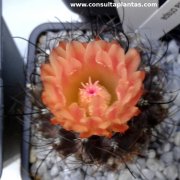Care of the cactus Eriosyce crispa or Neoporteria crispa |
|
The genus Eriosyce, family Cactaceae, includes 35 species of cactus native to Chile, Peru, and Argentina. Some species are: Eriosyce crispa, Eriosyce taltalensis, Eriosyce napina, Eriosyce esmeraldana, Eriosyce curvispina, Eriosyce paucicostata, Eriosyce senilis, Eriosyce aurata. Scientific synonyms: Neoporteria crispa, Horridocactus crispus, Neochilenia nigriscoparia. This species is native to Atacama, Chile. They are cacti with a cylindrical or flattened body and brownish-green epidermis that reach 10 cm (3.93") in diameter. They have bulging tubercles and woolly areolas with 6-14 curved radial spines and 1-5 thicker central spines. The flowers are funnel-shaped and can be pink, red, or white. Neoporteria crispa is used in pots as indoor, balcony or greenhouse plants. Eriosyce crispa needs a very bright exposure and good ventilation. In Mediterranean climates it appreciates a light shade in the central hours of the day. It resists frost (with the dry substrate) of -5 ºC (23 ºF). The soil can be a mixture of 70% coarse siliceous sand and 30% leaf mulch. Transplant every 2 years to renew the substrate. Water moderately in spring and summer waiting for the soil to be dry. In mid-autumn they stop watering until spring. Fertilize in spring with a mineral fertilizer for cacti rich in potassium. Neoporteria crispa does not need pruning. Its worst enemy is excess moisture; Eriosyce crispa is very sensitive to tissue rot. They propagate by seeds sown in spring in a sandy substrate at 22 ºC (71.6 ºF). |
Images of the cactus Eriosyce crispa or Neoporteria crispa |
Find plants
Eriosyce crispa or Neoporteria crispa | Care and Growing
© 2025 FavThemes



